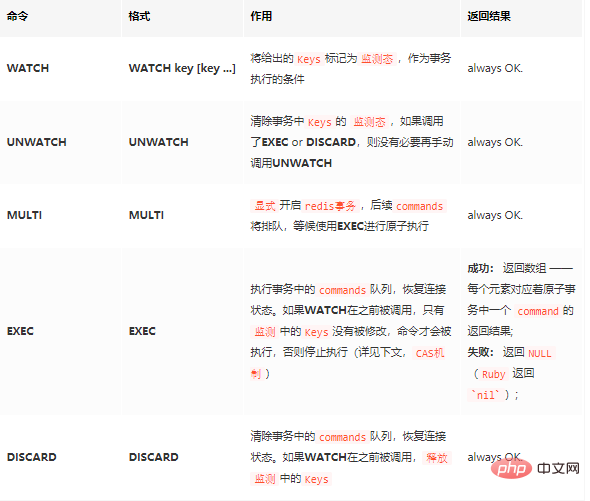Redis Pit Prevention Guide - Transactions

Related command introduction:
(Learning video sharing: redis video tutorial)

Note:
------MULTI, EXEC, DISCARD are common commands to explicitly start and control transactions, which can be compared to BEGAIN, COMMIT, ROLLBACK in relational databases (in fact, the gap Very large);
------The use of the WATCH command is to solve the problem of non-repeatable reading and phantom reading caused by transaction concurrency (simply understood as locking the Key);
RedisTransaction
MULTI, EXEC, DISCARD and WATCH are the basis of Redis transaction. Used to explicitly start and control a transaction, they allow a set of commands to be executed in one step. And provides two important guarantees:
All commands in the transaction will be serialized and executed in order. During the execution of a Redis transaction, no request issued by another client will occur. This ensures that the command queue is executed as a single atomic operation.
The commands in the queue are either all processed or ignored. The EXEC command triggers the execution of all commands in the transaction. Therefore, when the client loses the connection to the server in the transaction context, if it occurs before the MULTI command is called, no commands are executed; if the EXEC command is called before this, all commands are executed. All commands are executed.
At the same time, redis uses AOF (append-only file) to write transactions to disk using an additional write operation. If there is a downtime, process crash, etc., you can use the redis-check-aof tool to repair the append-only file, so that the service can start normally and resume some operations.
Usage
Use the MULTI command to explicitly start the Redis transaction. This command always responds with OK. At this point the user can issue multiple commands, and Redis will not execute these commands, but queue them. After EXEC is called, all commands will be executed. Calling DISCARD can clear the commands queue in the transaction and exit the transaction.
The following example atomically increments the keys foo and bar.
>MULTI OK >INCR foo QUEUED >INCR bar QUEUED >EXEC 1)(整数)1 2)(整数)1
As can be seen from the above command execution, EXEC returns an array, in which each element is the return result of a single command in the transaction, and the order is the same as the order in which the command was issued. When a Redis connection is in the context of a MULTI request, all commands will be replied with the string QUEUED (sent as a status reply from the perspective of the Redis protocol) and queued in the command queue. Only when EXEC is called, the queued commands will be executed, and the real result will be returned at this time.
Errors in Transactions
During a transaction, two kinds of command errors may be encountered:
An error occurred before calling the EXEC command (COMMAND queuing failed). For example, the command may have syntax errors (wrong number of parameters, wrong command name...); or there may be certain critical conditions, such as insufficient memory (if the server has memory limits using the maxmemory directive).
The client will detect the first error before calling EXEC. By checking the status reply of the queued command (***Note: this refers to the queued status reply, not the execution result***), if the command responds with QUEUED, it has been queued correctly, otherwise Redis will return an error. If an error occurs while queuing a command, most clients will abort the transaction and clear the command queue. However:
Before Redis 2.6.5, in this case, after the EXEC command was called, the client would execute a subset of the commands (the ones that were successfully queued) and ignore previous errors. Starting from Redis 2.6.5, the server will remember errors that occurred during the accumulation of commands. When the EXEC command is called, it will refuse to execute the transaction and return these errors, while automatically clearing the command queue. An example is as follows:
>MULTI +OK >INCR a b c -ERR wrong number of arguments for 'incr' command
This is due to a syntax error in the INCR command, which will be detected before calling EXEC and terminate the transaction (version2.6.5).
An error occurred after calling the EXEC command. For example, using an incorrect value to perform an operation on a key (such as calling a List operation on a String value)
Errors that occur after the EXEC command is executed will not be treated specially: even if some commands in the transaction fail to execute , other commands will still be executed normally.
The example is as follows:
>MULTI +OK >SET a 3 +QUEUED >LPOP a +QUEUED >EXEC *2 +OK -ERR Operation against a key holding the wrong kind of value
EXEC returns a string array containing two elements, one element is OK, the other is -ERR…. Whether errors can be properly fed back to users depends on the implementation of the client library (such as Spring-data-redis.redisTemplate). It should be noted that even if the command fails, all other commands in the queue will be processed - Redis will not stop the processing of the command.
Redis transactions do not support Rollback (emphasis)
In fact, Redis commands may fail during transaction execution, but the remaining commands will continue to be executed instead of Rollback (transaction rollback). If you have used relational databases, this situation may seem strange to you. However, there is a good explanation for this situation:
Redis命令可能会执行失败,仅仅是由于错误的语法被调用(命令排队时检测不出来的错误),或者使用错误的数据类型操作某个Key: 这意味着,实际上失败的命令都是编程错误造成的,都是开发中能够被检测出来的,生产环境中不应该存在。(这番话,彻底甩锅,“都是你们自己编程错误,与我们无关”。)由于不必支持Rollback,Redis内部简洁并且更加高效。
“如果错误就是发生了呢?”这是一个反对Redis观点的争论。然而应该指出的是,通常情况下,回滚并不能挽救编程错误。鉴于没有人能够挽救程序员的错误,并且Redis命令失败所需的错误类型不太可能进入生产环境,所以我们选择了不支持错误回滚(Rollback)这种更简单快捷的方法。
清除命令队列
DISCARD被用来中止事务。事务中的所有命令将不会被执行,连接将恢复正常状态。
> SET foo 1 OK > MULTI OK > INCR foo QUEUED > DISCARD OK > GET foo "1"
相关推荐:redis数据库教程
The above is the detailed content of Redis Pit Prevention Guide - Transactions. For more information, please follow other related articles on the PHP Chinese website!

Hot AI Tools

Undresser.AI Undress
AI-powered app for creating realistic nude photos

AI Clothes Remover
Online AI tool for removing clothes from photos.

Undress AI Tool
Undress images for free

Clothoff.io
AI clothes remover

Video Face Swap
Swap faces in any video effortlessly with our completely free AI face swap tool!

Hot Article

Hot Tools

Notepad++7.3.1
Easy-to-use and free code editor

SublimeText3 Chinese version
Chinese version, very easy to use

Zend Studio 13.0.1
Powerful PHP integrated development environment

Dreamweaver CS6
Visual web development tools

SublimeText3 Mac version
God-level code editing software (SublimeText3)

Hot Topics
 1386
1386
 52
52
 How to build the redis cluster mode
Apr 10, 2025 pm 10:15 PM
How to build the redis cluster mode
Apr 10, 2025 pm 10:15 PM
Redis cluster mode deploys Redis instances to multiple servers through sharding, improving scalability and availability. The construction steps are as follows: Create odd Redis instances with different ports; Create 3 sentinel instances, monitor Redis instances and failover; configure sentinel configuration files, add monitoring Redis instance information and failover settings; configure Redis instance configuration files, enable cluster mode and specify the cluster information file path; create nodes.conf file, containing information of each Redis instance; start the cluster, execute the create command to create a cluster and specify the number of replicas; log in to the cluster to execute the CLUSTER INFO command to verify the cluster status; make
 How to clear redis data
Apr 10, 2025 pm 10:06 PM
How to clear redis data
Apr 10, 2025 pm 10:06 PM
How to clear Redis data: Use the FLUSHALL command to clear all key values. Use the FLUSHDB command to clear the key value of the currently selected database. Use SELECT to switch databases, and then use FLUSHDB to clear multiple databases. Use the DEL command to delete a specific key. Use the redis-cli tool to clear the data.
 How to read redis queue
Apr 10, 2025 pm 10:12 PM
How to read redis queue
Apr 10, 2025 pm 10:12 PM
To read a queue from Redis, you need to get the queue name, read the elements using the LPOP command, and process the empty queue. The specific steps are as follows: Get the queue name: name it with the prefix of "queue:" such as "queue:my-queue". Use the LPOP command: Eject the element from the head of the queue and return its value, such as LPOP queue:my-queue. Processing empty queues: If the queue is empty, LPOP returns nil, and you can check whether the queue exists before reading the element.
 How to use the redis command
Apr 10, 2025 pm 08:45 PM
How to use the redis command
Apr 10, 2025 pm 08:45 PM
Using the Redis directive requires the following steps: Open the Redis client. Enter the command (verb key value). Provides the required parameters (varies from instruction to instruction). Press Enter to execute the command. Redis returns a response indicating the result of the operation (usually OK or -ERR).
 How to use redis lock
Apr 10, 2025 pm 08:39 PM
How to use redis lock
Apr 10, 2025 pm 08:39 PM
Using Redis to lock operations requires obtaining the lock through the SETNX command, and then using the EXPIRE command to set the expiration time. The specific steps are: (1) Use the SETNX command to try to set a key-value pair; (2) Use the EXPIRE command to set the expiration time for the lock; (3) Use the DEL command to delete the lock when the lock is no longer needed.
 How to read the source code of redis
Apr 10, 2025 pm 08:27 PM
How to read the source code of redis
Apr 10, 2025 pm 08:27 PM
The best way to understand Redis source code is to go step by step: get familiar with the basics of Redis. Select a specific module or function as the starting point. Start with the entry point of the module or function and view the code line by line. View the code through the function call chain. Be familiar with the underlying data structures used by Redis. Identify the algorithm used by Redis.
 How to solve data loss with redis
Apr 10, 2025 pm 08:24 PM
How to solve data loss with redis
Apr 10, 2025 pm 08:24 PM
Redis data loss causes include memory failures, power outages, human errors, and hardware failures. The solutions are: 1. Store data to disk with RDB or AOF persistence; 2. Copy to multiple servers for high availability; 3. HA with Redis Sentinel or Redis Cluster; 4. Create snapshots to back up data; 5. Implement best practices such as persistence, replication, snapshots, monitoring, and security measures.
 How to use the redis command line
Apr 10, 2025 pm 10:18 PM
How to use the redis command line
Apr 10, 2025 pm 10:18 PM
Use the Redis command line tool (redis-cli) to manage and operate Redis through the following steps: Connect to the server, specify the address and port. Send commands to the server using the command name and parameters. Use the HELP command to view help information for a specific command. Use the QUIT command to exit the command line tool.




